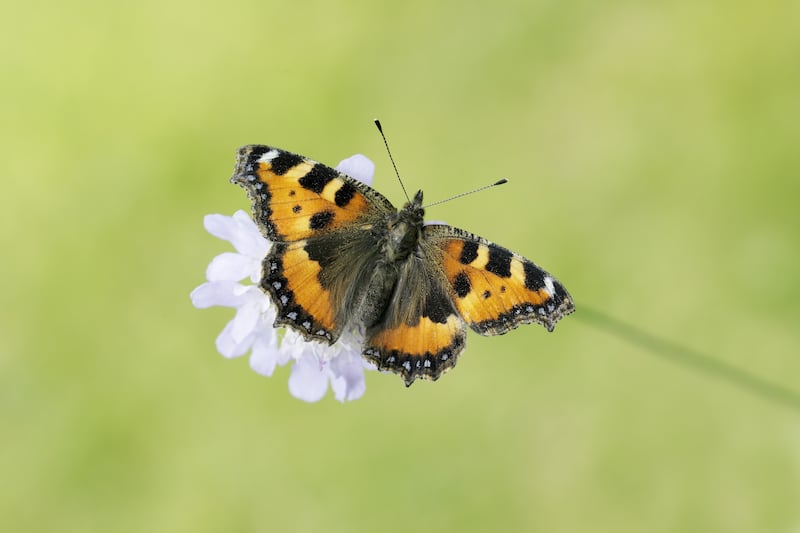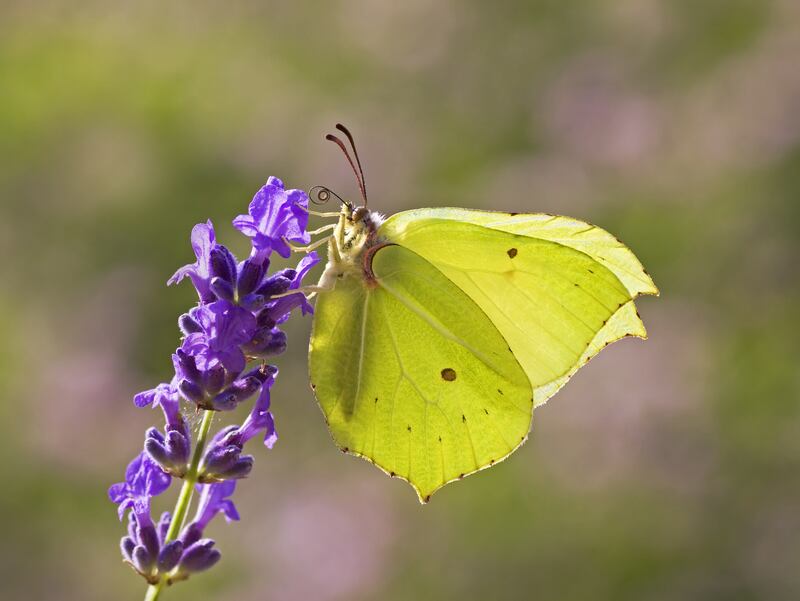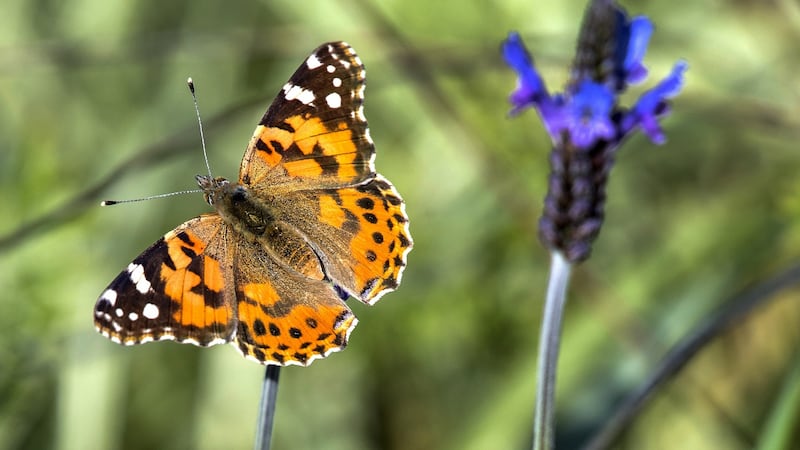When you come from a sprawling Irish family like I do, WhatsApp is the strange but very 21st-century glue that connects us long after everyone has fled the nest.
Through it, we share opinions, memories, gossip, photos, silly videos and chitchat, argue about everything from politics to the perils of social media and commiserate with each other about the indignities of ageing, from the probability of developing supernaturally long eyebrow hairs to the possibility of becoming slowly but surely deaf. We bicker about the finer points of modern manners, remind each other about significant birthdays, and speculate about the different directions in which our lives are heading.
We also talk about our gardens.
So when my oldest brother recently proudly shared a photograph on the family WhatsApp group of what he thought was a rare species of butterfly grazing on the wildflowers in his garden, it reminded me of my childhood obsession with these magical creatures. Of the special thrill of watching clouds of tortoiseshells, red admirals and peacocks feeding on the flowers of an old buddleia bush that grew in the family garden, a clamour of colour and fluttering wings.
READ MORE
Of the first time I ever saw a fritillary in flight, a butterfly of such beauty that it genuinely took my breath away. Of the quiet meadow browns and ringlets that filled the hedgerows and nearby woodlands, so subtle in their colouring that it was as though they were wearing camouflage.


Butterflies are nothing like as numerous now as they were back then, as the combined challenges of climate change and habitat loss continue to undermine populations of what were once common species. According to the Irish butterfly monitoring scheme, which has been tracking changes in butterfly populations of 15 of the most common species since 2008, the overall trend is downwards. Europe has lost 30 per cent of its grassland butterfly populations since 1990.
But the silver lining is that this decline is not being seen across the board. Populations of the majestic peacock, for example, are up by 185 per cent since those records first began, while other common species including the brimstone, small tortoiseshell, holly blue and dingy skipper are experiencing what are described as moderate increases.
It’s also cheering to know that as gardeners, there are many small but significant things that we can do to help support butterfly populations. First and foremost, by avoiding the use of herbicides, insecticides and fungicides that do untold damage to them and to their vulnerable habitats. But also by something as simple as leaving just a little patch of the garden to return to semi-wilderness as a way of providing them with the “weeds” – examples include nettles, thistles, ivy, dock, knapweed – that the larvae of many species rely on as a source of food.
Similarly, by leaving sections of our lawns uncut so that wild grasses can flourish, providing food and shelter for the larvae of species such as the speckled wood, wall brown, grayling, gatekeeper, meadow brown, ringlet and small heath. Also by not being overly tidy-minded when it comes to clearing out garden sheds, garages and outbuildings, which offer the perfect spots for overwintering species to hibernate during the coldest, darkest days of the year.
Equally, by providing shelter so that they can bask in sunlight (a crucial way for butterflies to increase their body temperature) as well as more comfortably take to the wing in search of food, a mate and a place to lay their eggs (butterflies struggle to fly in cool conditions).
All these aside, one of the most obvious ways to support them is by growing a wide diversity of flowering plants to provide the adult butterflies with a ready source of nectar, the sweet and highly nutritious liquid that they need for food. Because unlike the larvae or caterpillars, which like to chew on leaves, adult butterflies don’t so much “eat” in the conventional sense of the word as daintily sip. Look at a close-up photograph of one feeding from a flower, and you might see the natural engineering marvel that is its proboscis, the long, slender hollow tube (similar to a straw) that it uses to suck the nectar out from deep within those petals.

At this time of year, with Irish gardens, meadows, hedgerows and wild flowers in full summer bloom, it’s relatively easy for butterflies to find that all-important food. Examples of nectar-rich late summer flowering shrubs, perennials, biennials and annuals that attract them include the aforementioned buddleia or butterfly bush, cistus, hebe, roses, potentilla, ivy, brambles, sedum/hytotelephium, verbena, echinacea, echinops, aster, lavender, helenium, marjoram, perovskia, monarda, Michaelmas daisies, dahlias (those with single rather than double flowers), purple loosestrife, phlox, fennel, scabious, salvia, cosmos, dill, alyssum, stock, cornflowers and pot marigolds.
Many of these plants have flowers that are in the deep pink/purple/ violet/orange spectrum, shades that are particularly attractive to butterflies whose ability to see and distinguish colour is quite different to ours.
These kinds of late summer/autumn flowering plants are very important for butterflies as the insects begin to store up energy in preparation for either hibernation or migration to warmer climes. But bear in mind that for a truly butterfly-friendly garden, it’s every bit as important to provide them with an almost-year-round source of food. In this way you’ll support hibernatory species as they hungrily emerge in spring, and migratory species as they arrive in spring and early summer, exhausted after what are often staggeringly long journeys from far away countries.
Again, the flowers of many of our most common garden weeds provide a ready source of nectar at that all-important time of the butterfly year including buttercups, dandelions, and celandines. Many of our most common wildflowers also, including primroses, cowslips, clover and the cuckoo-flower.

Examples of cultivated spring and early summer-flowering garden plants that act as a butterfly restaurant include: fruit trees (pear, plum cherry), hawthorn, pussy willow, goat willow, flowering currant, cotoneaster, escallonia, aubrietia, bergenia, doronicum, hyacinth, wallflowers, scillas, pulmonaria, honesty, sweet rocket, sweet William, honeysuckle, thyme, aquilegia and campion.
Grow even a few of the above in your garden or allotment and you’ll be amazed by the different species that will start to visit it. But in the meantime, relish the coming weeks for the annual delight that is the spectacle of so many of these magical creatures on the wing. Record them if you can. Take note of the plants that they visit, the flowers they feed from, the corners of the garden they favour, the weather conditions that encourage them. Count how many different species you spot.
Not sure? Then visit the website of the National Biodiversity Data Centre (bioversityireland.ie) which offers a number of excellent online resources including a downloadable butterfly poster and free online course in identifying butterflies. You can also email them at butterflies@biodiversityireland.ie
This Week in the Garden
For those going away on holidays over the coming weeks, there’s always the worry of how to keep container-grown plants happy in your absence. Along with giving them a very generous watering the day before you leave, tips include clustering pots tightly together in an area that doesn’t receive direct sunshine for a large part of the day; placing deep saucers filled with water beneath the pots; and leaving windows, doors and vents wide open in glasshouses and polytunnels and creating some form of shade using shade netting or shade paint. It’s also always a good idea to thoroughly deadhead and liquid-feed container-grown plants before you go. Indoor plants can be placed in the bath or bathroom sink on some very damp towels to keep them hydrated.
Tomato plants are in rampant growth at this time of year and need to be given regular attention in terms of side-shooting, maintaining a correct watering and feeding regime, and properly supporting their fruit-laden stems. For a detailed guide to getting the very most out of your plants, visit the website and blog of the Dublin-based organic gardener and tomato expert Nicky Kyle, aka the Tomato Queen, who shares a wealth of tips and advice; see nickykylegardening.com.
Dates For Your Diary
Continuing until Monday, August 1st, the last of this year’s Carlow Garden Festival garden talks and tours includes Ken Cox at Huntington Castle today (11am); Finola Reid at Burtown House and gardens today (3pm); Fiann O’Nuallain at the community garden An Gairdin Beo tomorrow (3pm) and Eanna ni Lamhna in Myshall village on Monday (2.30pm), see carlowgardentrail.com.
Continuing today , Maynooth University, Maynooth, Co Kildare, the 74th Annual FIBKA Beekeeping Summer School with a wealth of talks, training sessions, practical workshops and demonstrations, trade stands and exhibits plus the Irish National Honey Show, see irishbeekeeping.ie;
On Sunday, (10am-5pm), Farmleigh Plant Fair, Farmleigh, Phoenix Park, Dublin with 25 of the country’s best specialist nurseries in attendance selling plants and garden goods, garden talks and floral displays, see farmleigh.ie.
Throughout August at June Blake’s garden, Tinode, Blessington, Co Wicklow , “A Month of Dahlias” will be celebrating this beautiful and diverse genus of summer-/autumn-flowering plants with a talk/guided tour by June every Sunday throughout the month at 2pm. The garden’s new indoor plant and coffee shop Epoch Green will also be hosting an outdoor party with live music in the gardens on August 6th (1.30pm), see juneblake.ie and epochgreen.ie.
















